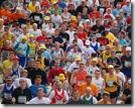 The summer Olympics took place in August this year, hosted by both Beijing and Hong Kong. Every event has its own group of dedicated followers who are prepared to miss sleep and discuss their sports heroes endlessly - whether it is a freestyle swimmer, a javelin thrower, or a marathon runner. As always, one of the premier events was the 100 meter sprint where athletes complete for the title of the fastest man or woman in the world.
The summer Olympics took place in August this year, hosted by both Beijing and Hong Kong. Every event has its own group of dedicated followers who are prepared to miss sleep and discuss their sports heroes endlessly - whether it is a freestyle swimmer, a javelin thrower, or a marathon runner. As always, one of the premier events was the 100 meter sprint where athletes complete for the title of the fastest man or woman in the world. Top athletes will cover the 100 meter distance in less than 10 seconds, meaning that they are travelling at an average speed of 10 meters per second. Unless you have some experience in sprinting you may not appreciate this feat. Imagine what would happen if you and few of your work colleagues were to race an Olympic athlete. Well, it is likely that the results would be quite embarrassing. The Olympian would probably finish between two and five seconds—that's 20 to 50 meters—ahead of the non-olympian competitors. And if you raced later that day, the next day, the next week, and the next month, the result would always be the same. If we think of sprinting as a field of expertise, then it is simple to distinguish the experts from the non-experts. Expertise is easily demonstrated and recognized in many fields. Piano playing, ballet and cooking are examples. But there is one field where the track record of many so-called experts is quite dismal, and that is in the area of decision making.
We need look no further than information technology (IT) for predictions and decisions that have turned out to be spectacularly wrong. In 1943 the chairman and founder of IBM, Thomas Watson, thought that there was a world market for about 5 computers (they were much bigger back then). About thirty years later, Ken Olsen the then head of DEC computers, could not see why anyone would want a computer in his home. And more recently, Tim Berners-Lee spent several years trying to convince managers at CERN (the European Center for Nuclear Research) that his HTTP protocol was a good thing (he later went on to invent the World Wide Web). Apparently there is a shortage of Olympian IT decision makers.
 In a recent book, The Wisdom of Crowds, author James Surowiecki examines a collection of problems that seem better suited to solve by involving many non-experts rather than relying on a few experts. His book opens with an anecdote from Francis Galton, a famous British scientist, as he strolled through a country fair in 1906.
In a recent book, The Wisdom of Crowds, author James Surowiecki examines a collection of problems that seem better suited to solve by involving many non-experts rather than relying on a few experts. His book opens with an anecdote from Francis Galton, a famous British scientist, as he strolled through a country fair in 1906.
Galton came upon a contest where people were asked to guess the weight of an ox on display. Around 800 people tried their luck, paying a sixpence to guess the ox’s weight in return for the chance of winning a prize. After the contest was over, Galton decided to perform an impromptu experiment—take all the submitted guesses and see how close the average of these answers was to the true weight of the ox. Galton thought surely that the average guessed weight must be far from the true weight since so many people of varied backgrounds and abilities (a general crowd) had submitted guesses.
But to Galton’s surprise, the true weight of the ox was 1,198 pounds and the average of the guesses was 1,197 pounds. Thus a crowd of people at a country fair had collectively determined the weight of the ox to within one pound, or less than half a kilogram.
 The book goes on further to discuss which types of problems can be effectively solved by crowds, and under what conditions the crowd will be expected to produce a good solution. Risk management is about making decisions today that will protect us from the uncertainty of the future. We are not looking for one in a million (the expert) but rather a million and one (the power of many). The recent subprime debacle has highlighted the shortcomings of quantitative models. Risk scenarios and rankings produced through a consensus process involving many people (a crowd) are likely to produce more meaningful results.
The book goes on further to discuss which types of problems can be effectively solved by crowds, and under what conditions the crowd will be expected to produce a good solution. Risk management is about making decisions today that will protect us from the uncertainty of the future. We are not looking for one in a million (the expert) but rather a million and one (the power of many). The recent subprime debacle has highlighted the shortcomings of quantitative models. Risk scenarios and rankings produced through a consensus process involving many people (a crowd) are likely to produce more meaningful results.
Your involvement is both necessary and critical.



2 comments:
OBAT AMBEIEN
OBAT AMBEIEN
OBAT AMBEIEN
OBAT AMBEIEN
thank you for the information, visit my website atas
obat gondok beracun
Post a Comment